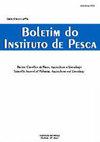Reproductive pattern and population dynamics of Anchovia surinamensis in a seasonal floodplain lake of the Amazon basin*
IF 0.6
4区 农林科学
Q4 FISHERIES
引用次数: 0
Abstract
The Surinam anchovy (Anchovia surinamensis) is a small fish of commercial and ecological interest in the Amazon basin. To understand the reproductive and population dynamics of this species, in 2019 and 2020, experimental fisheries were carried out during periods of flood and low water in the Cujubim Lake in Porto Velho (Rondônia, Brazil). This study aimed to analyze the seasonal pattern (flood and low water) for the reproductive period and the population dynamics of the Surinam anchovy in this region, which resulted in the collection of 870 individuals. The specimens showed mean lengths (Ls) of 6.85 ± 0.51 cm to 9.01 ± 2.56 cm and mean weight (Wt) of 5.8 ± 3.37 g to 6.6 ± 2.72 g between low and flood water periods, respectively. The growth parameters for this species (Wt = 0.0226*Ls2,6635; Natural mortality, M = 1.66 year-1; Growth rate, k = 0.70 year-1; Asymptotic length, L∞ = 16.53 cm; Theoretical maximum weight, W∞ = 42.83 g) and the quantity of individuals in mature stages during periods of flood and low water were also evaluated. The mean values of Gonadosomatic index - GSI (5.41 and 4.96 between females and males) and animal welfare index, Kn (1.009 and 1.010 between low and flood water periods) did not show significant differences. All the population growth information presented, added to the values of physicochemical parameters of the water (which were suitable for tropical fish) indicates that the Surinam anchovy population is governed by hydrological seasonality and is well adapted to the floodplain lake where it colonizes and reproduces.亚马逊河流域季节性漫滩湖泊中苏里南鳀鱼的繁殖模式和种群动态
苏里南凤尾鱼是一种在亚马逊流域具有商业和生态价值的小鱼。为了了解该物种的繁殖和种群动态,2019年和2020年,在波尔图韦柳(Rondônia,巴西)的Cujubim湖的洪水和低潮期间进行了实验渔业。本研究旨在分析苏里南凤尾鱼繁殖期的季节格局(洪水和低潮)及种群动态,共采集了870尾鱼。在枯水期和丰水期,标本的平均长度(Ls)分别为6.85±0.51 cm ~ 9.01±2.56 cm,平均重量(Wt)为5.8±3.37 g ~ 6.6±2.72 g。该物种的生长参数(Wt = 0.0226*Ls2,6635;自然死亡率,M = 1.66;增长率,k = 0.70 -1年;渐近长度,L∞= 16.53 cm;对理论最大体重W∞= 42.83 g)和洪涝期和低潮期成熟期个体数量进行了评价。性腺指数GSI(雌性和雄性分别为5.41和4.96)和动物福利指数Kn(低潮期和丰潮期分别为1.009和1.010)的平均值无显著差异。所有的种群增长信息,加上水的物理化学参数值(适合热带鱼)表明,苏里南凤尾鱼种群受水文季节性的支配,并且很好地适应了它在漫滩湖泊的殖民和繁殖。
本文章由计算机程序翻译,如有差异,请以英文原文为准。
求助全文
约1分钟内获得全文
求助全文
来源期刊

Boletim do Instituto de Pesca
FISHERIES-ZOOLOGY
CiteScore
0.80
自引率
0.00%
发文量
24
审稿时长
>12 weeks
期刊介绍:
To publish original articles of research and short communications in the following áreas: Fisheries, Aquaculture, Zootechnology, Limnology, Oceanography, Biology and Pathology of aquatic organisms. The publication depends on the approval of the Editorial Board, based on the peer review.
 求助内容:
求助内容: 应助结果提醒方式:
应助结果提醒方式:


